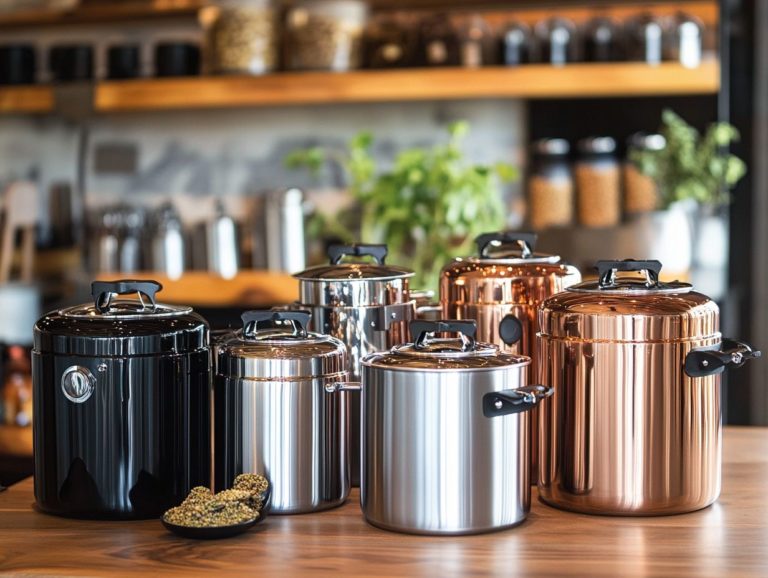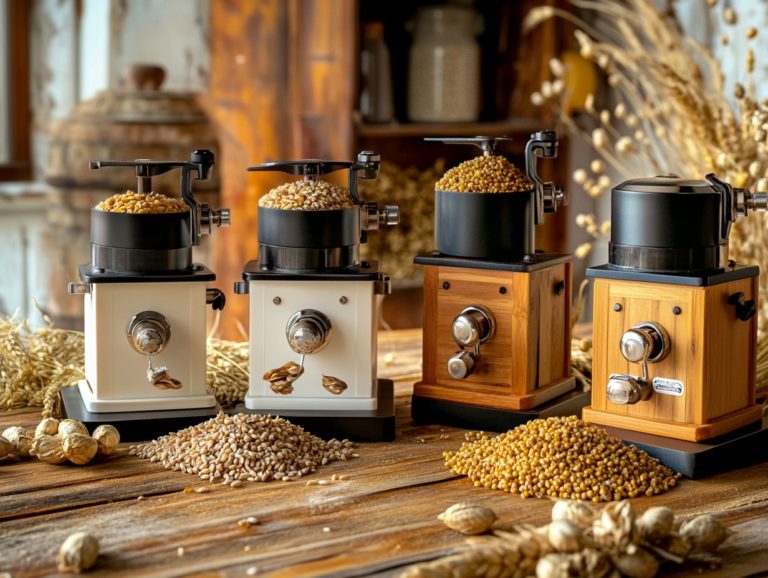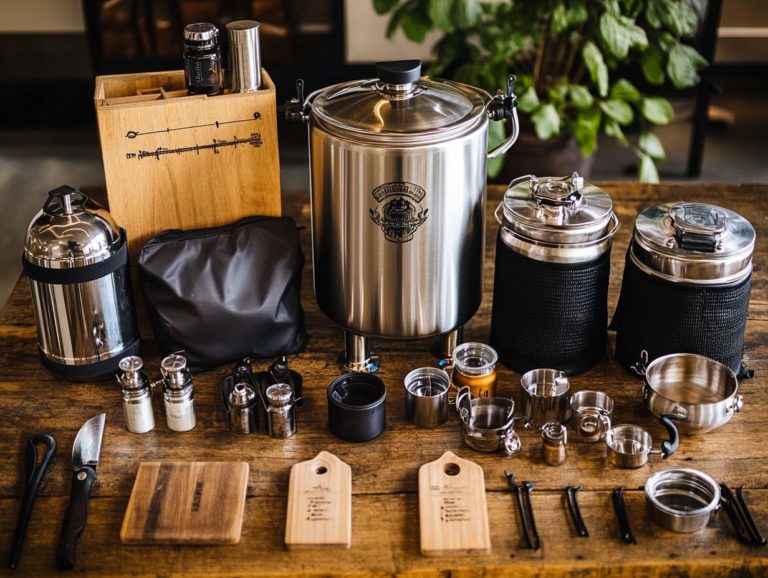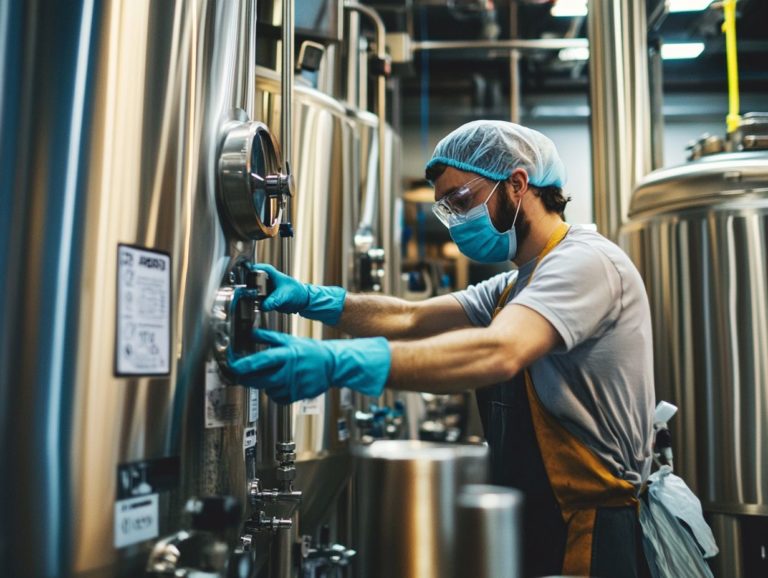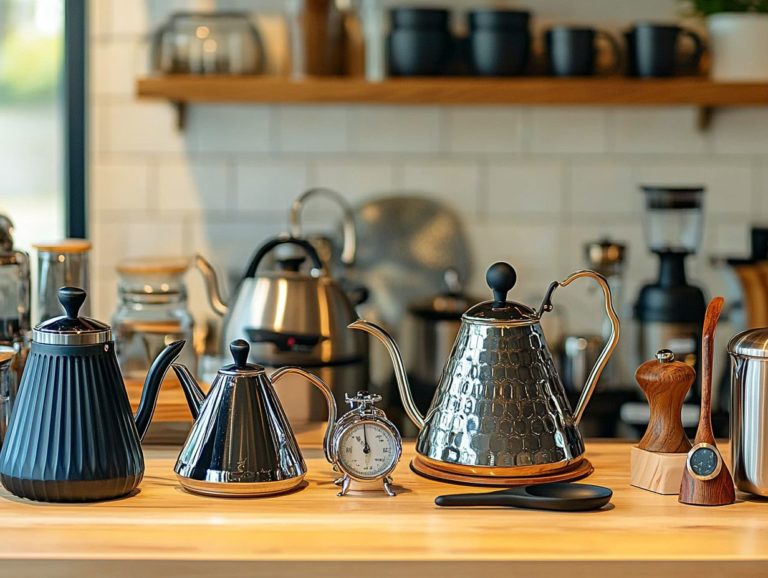How to Ensure Your Brewing Equipment is Safe
Brewing can be a deeply rewarding hobby or even a fulfilling profession. However, it’s essential to recognize the inherent risks involved. Understanding the importance of safety when it comes to brewing equipment and maintaining beer quality is vital for preventing accidents, injuries, and contamination.
The potential dangers are very real, ranging from burns and cuts to electrical hazards and chemical exposure. This article delves into these hazards and offers practical tips for safeguarding your brewing equipment. Additionally, we will detail the steps to take should an accident occur.
Stay informed. Brew with utmost confidence!
Contents
- Why is Safety Important in Brewing Equipment?
- What are the Potential Hazards of Brewing Equipment?
- 3. Exposure to Chemicals and Fumes
- 4. Electrical Hazards
- 5. Fire Hazards
- How to Ensure Your Brewing Equipment is Safe?
- 1. Regular Maintenance and Inspections
- 2. Proper Use and Handling of Equipment
- 3. Use of Protective Gear
- 4. Proper Storage of Equipment and Ingredients
- Frequently Asked Questions
- What should I do to ensure my brewing equipment is safe?
- How often should I clean and sanitize my brewing equipment?
- What are some common damages I should look for in my brewing equipment?
- Why is it important to inspect my brewing equipment for damages?
- What are some proper handling techniques for brewing equipment?
- How should I store my brewing equipment when not in use?
Key Takeaways:
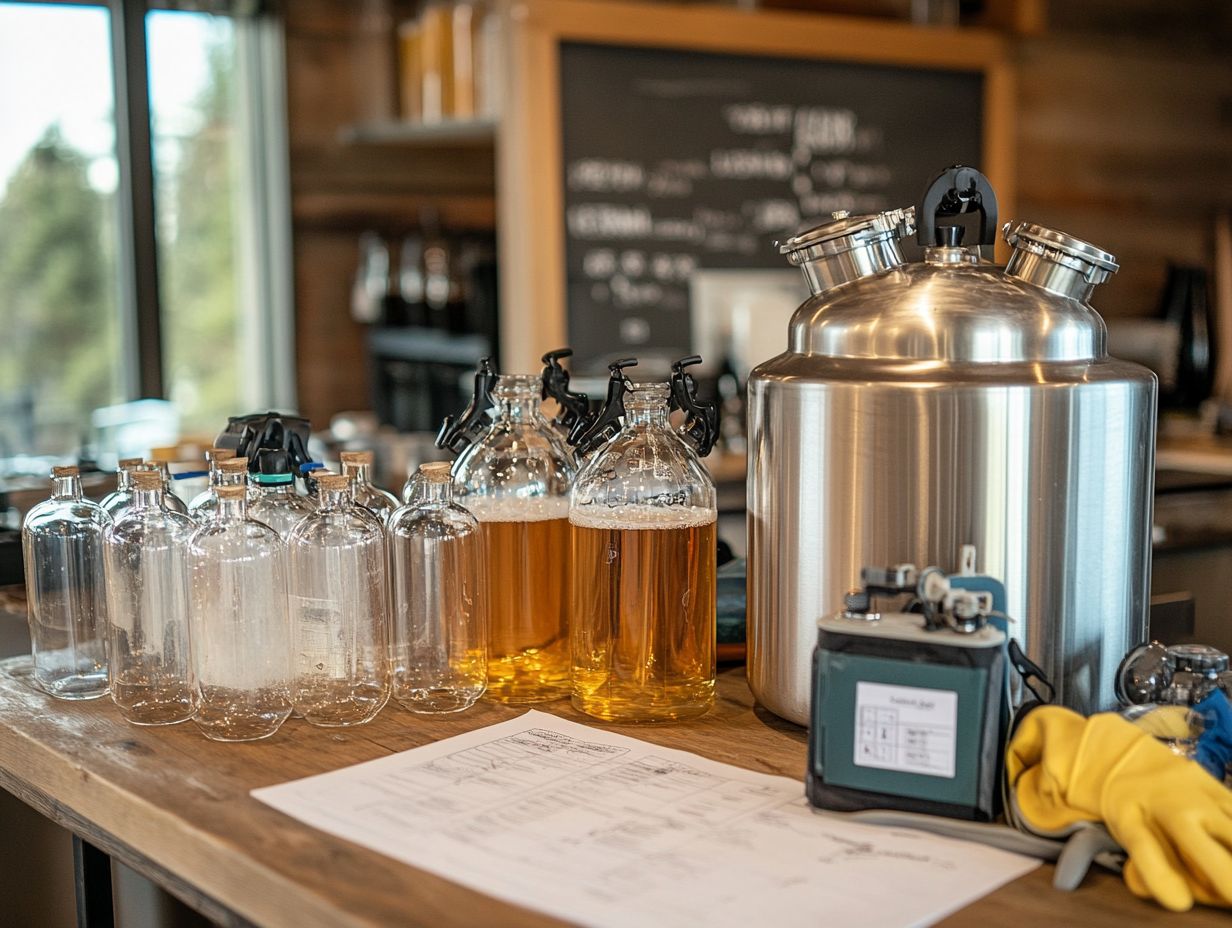
- Safety is crucial in brewing equipment to prevent accidents and injuries.
- Potential hazards include burns, cuts, chemical exposure, electrical and fire hazards.
- Ensure safety by regular maintenance, proper use and handling, use of protective gear, and knowledge of emergency procedures and cleaning practices.
Why is Safety Important in Brewing Equipment?
In the brewing industry, safety is of utmost importance, especially regarding brewing equipment. It directly impacts the quality of the beer you produce, your health as a brewer, and your adherence to Good Manufacturing Practices (GMP) standards.
If you neglect safety protocols, you risk contamination. This can jeopardize the brewing process and your health due to harmful bacteria, mold growth, and wild yeast contamination.
For any brewery, upholding high safety standards is crucial for safeguarding the customer experience and ensuring the longevity of the equipment.
What are the Potential Hazards of Brewing Equipment?
Brewing equipment is crucial to the art of crafting beer. However, it brings with it a variety of hazards that you must be diligent in addressing.
You could encounter burns from hot liquids and surfaces that are central to the brewing process. Additionally, you may experience cuts from sharp objects often used during equipment cleaning. Be aware of the risk of exposure to harmful chemicals and fumes from cleaning agents.
Moreover, you must also consider electrical hazards and fire risks that may stem from improper handling of the equipment. This highlights the paramount importance of adhering to safety protocols in your brewing endeavors.
1. Burns from Hot Liquids and Surfaces
Burns from hot liquids and surfaces are among the most common hazards you ll face during the brewing process. Various stages require heating water and wort (the liquid extracted from the mash during the brewing process) to high temperatures.
These risks can intensify during critical moments, such as transferring boiling wort from the kettle to the fermenter or when dealing with pressurized steam during cleaning and sanitizing. You might find yourself inadvertently touching scorching equipment, like mash tuns or plate chillers.
Act now to protect yourself against these dangers by wearing the right protective gear, including heat-resistant gloves and aprons. Follow a rigorous cleaning regimen.
By mastering proper equipment handling and keeping your workspace tidy, you can significantly reduce the risk of accidents. This ensures a safer brewing experience for everyone involved.
2. Cuts from Sharp Objects
Cuts from sharp objects pose a significant hazard in breweries. You often handle equipment like knives, hoses, and small tools that can easily lead to injuries if not managed properly.
Beyond knives, you ll encounter other sharp items such as glass bottles, keg components, and even the edges of metal tanks. All of these can deliver serious wounds during the beer production process. Busy brewing environments increase the risk of cuts and lacerations due to multitasking and lapses in attention.
To mitigate these risks, you should implement essential safety measures, such as:
- Wearing cut-resistant gloves
- Using designated cutting boards
- Ensuring all tools are properly maintained and stored
Regular training sessions on safe handling practices can further cultivate a culture of safety, enabling you to focus on your craft without the persistent worry of injuries.
3. Exposure to Chemicals and Fumes
Exposure to hazardous chemicals and fumes is a critical concern in any brewing operation. This is especially true when working with cleaning agents and sanitizers that might release harmful substances into the air.
Common cleaning solutions like sodium metabisulfite, iodine, and oxygen-based sanitizers like Star San and PBW are essential for maintaining hygiene and preventing contamination. If mishandled, they pose serious health risks. For instance, sodium metabisulfite can emit sulfur dioxide gas, which may irritate your eyes and respiratory system. Meanwhile, iodine can lead to skin irritation and allergic reactions in some people.
To mitigate these hazards, it s vital for you to don appropriate protective gear, such as gloves and masks. Ensure that your workspace is well-ventilated. By implementing strict guidelines for the safe use and storage of these chemicals and sanitizers, you can further enhance safety in your brewing environment.
4. Electrical Hazards
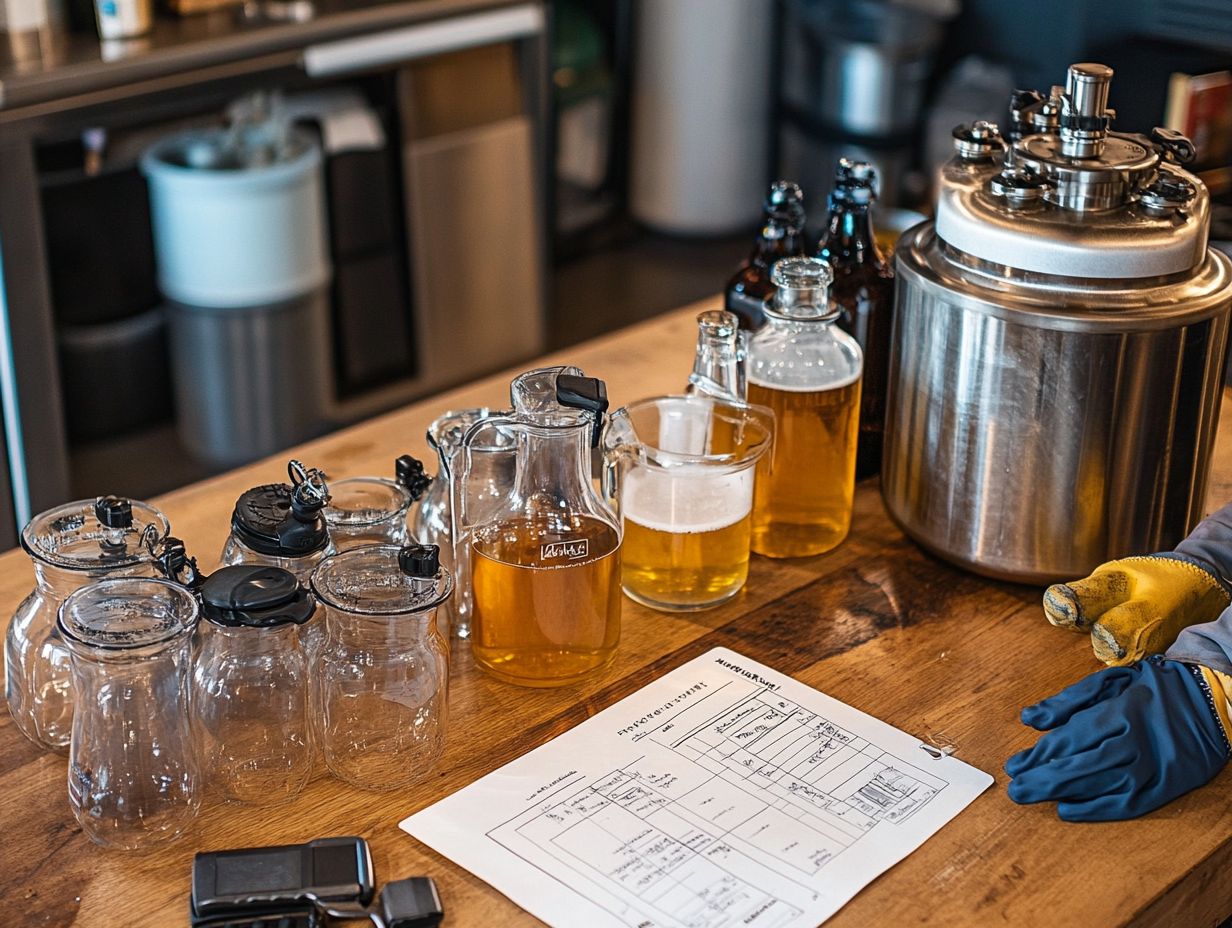
Electrical hazards in brewing equipment can emerge from improper wiring or faulty devices, presenting significant safety risks as well as potential operational failures.
The intricate dynamics of brewing processes often necessitate the use of heavy machinery, pumps, and heating elements. All of these depend on a reliable electrical supply for their optimal performance. When these components aren t regularly inspected or maintained, the probability of malfunctions escalates dramatically.
To avert electrical accidents in your brewing environment, it is essential for you to adhere to stringent safety protocols, such as:
- Utilizing Ground Fault Circuit Interrupters (GFCIs)
- Ensuring all wiring complies with local codes
- Conducting frequent equipment inspections
Implementing comprehensive training for your staff helps recognize potential electrical issues and safeguards against accidents. This ensures both the longevity and efficiency of your brewing equipment.
5. Fire Hazards
Fire hazards pose a significant risk in brewing operations, especially when working with flammable materials and high-temperature equipment essential to the brewing process. This includes handling alcohol and other chemical solutions that can be highly flammable.
These risks intensify with improper storage practices, such as placing flammable liquids too near heat sources or neglecting to secure chemical containers adequately. Equipment like kettles, burners, fermentation tanks, and refrigeration units can generate substantial heat, presenting potential ignition risks if not properly maintained.
Take action now to mitigate these dangers. Breweries should establish strict safety protocols, including regular inspections of storage areas and equipment to ensure compliance with safety standards. Additionally, conducting comprehensive training sessions for staff on proper handling techniques and emergency procedures can greatly enhance overall safety in the brewery, fostering a culture of vigilance and preparedness.
How to Ensure Your Brewing Equipment is Safe?
To safeguard your brewing equipment effectively, it’s crucial to adopt a comprehensive strategy that encompasses regular maintenance, thorough inspections, and the diligent use of protective gear throughout all brewing activities. This should also include a meticulous cleaning regimen to maintain equipment lifespan and hygiene.
This proactive approach allows you to identify potential issues before they develop into serious problems. It also fosters a robust culture of safety within your brewing environment.
By following these practices, you significantly mitigate the risks associated with equipment use and elevate the overall quality of your brewing operations.
In conclusion, prioritizing safety in your brewing operations is not just a regulatory requirement, but a commitment to creating a secure and efficient working environment for everyone involved.
1. Regular Maintenance and Inspections
Regular maintenance and inspections of your brewing equipment are essential practices that ensure safety and adherence to established standards. This is especially important when handling complex machinery like kettles, fermenters, and heat exchangers.
Routine checks on your kettles confirm that their temperature and pressure gauges are functioning correctly, preventing potential overheating. Inspecting your fermenters for leaks is crucial; any breach could lead to contamination, jeopardizing the quality and safety of your product.
Committing to these maintenance protocols enhances the reliability of your brewing operations and minimizes risks associated with chemical hazards and equipment failures. Prioritizing these practices is vital for any brewery aiming to uphold the highest safety standards and ensure a superior customer experience.
2. Proper Use and Handling of Equipment
Proper use and handling of brewing equipment are crucial for minimizing risks and ensuring safety. This includes following good practices and implementing a thorough cleaning regimen.
Training your staff on correct operation and maintenance of this equipment not only enhances safety but also significantly extends the lifespan of the machinery. Regular safety drills and workshops help employees become familiar with emergency protocols and the right techniques for handling equipment.
Keep a clean workstation and routinely check equipment for wear and tear to prevent accidents and reduce downtime. Regularly sanitizing brewing equipment also helps prevent mold and bacteria growth. Fostering a culture of safety and accountability can lead to smoother workflows and a safer working environment.
3. Use of Protective Gear
Using protective gear is vital for your safety in the brewery! It can dramatically lower your risk of injury and exposure to health hazards such as chemical solution spills.
The potential dangers vary based on the task at hand. When handling hot liquids or heavy equipment, wearing insulated gloves shields your hands from burns and enhances grip. Protective goggles are crucial for protecting your eyes from harmful substances, especially when dealing with chemicals.
- Insulated gloves: Protects hands from burns.
- Protective goggles: Safeguards eyes from splashes.
- Apron: Shields clothing from stains and spills.
Properly sanitizing protective gear is also crucial to avoid contamination. These items ensure a safe and efficient brewing experience, allowing you to focus on crafting your brews without unnecessary worries.
4. Proper Storage of Equipment and Ingredients
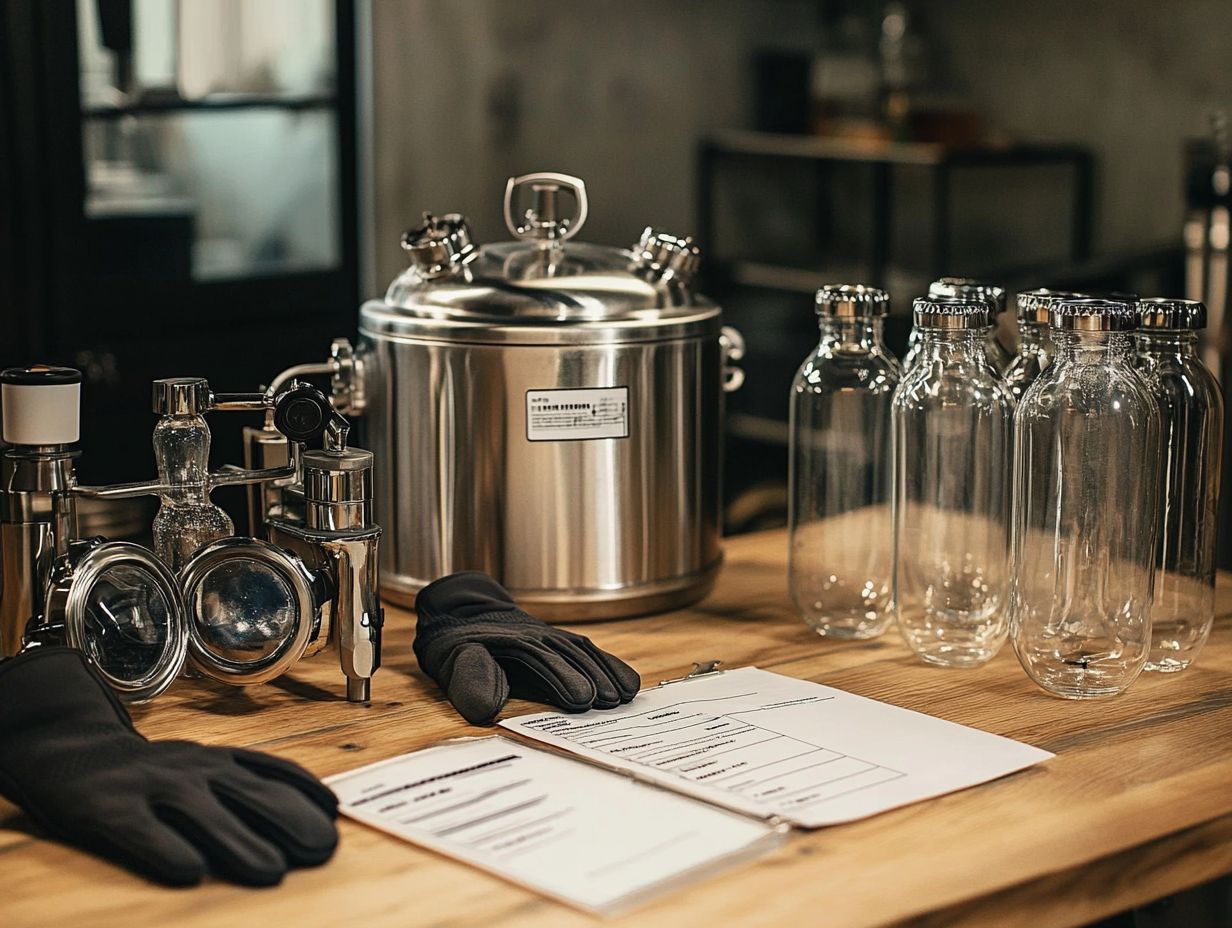
Proper storage of your brewing equipment and ingredients is essential for maintaining safety and preventing accidents and contamination in your brewing environment.
Thoughtfully organizing everything enhances efficiency and creates a safer workspace. Regular inventory checks help identify expired ingredients, while clearly labeling containers ensures everyone handles them with care. Keep an eye out for wild yeast and mold to maintain ingredient quality.
Keep flammable materials away from heat sources to minimize fire hazards. Utilize designated shelving units and cabinets to promote cleanliness while providing easy access to essential tools and supplies. Use appropriate cleaning solutions like Star San and Oxiclean to keep your workspace uncontaminated. This approach reinforces a culture of safety with every batch you brew.
Implement these practices immediately for your safety and efficiency in the brewery!
5. Knowledge of Emergency Procedures
Understanding emergency procedures is vital for you and everyone involved in a brewing operation. It prepares you to respond effectively to unexpected incidents.
In the brewing environment, emergencies can vary significantly from equipment malfunctions and chemical spills to fire hazards and severe weather events. Each scenario requires a tailored response. This may include activating fire suppression systems, implementing evacuation plans, or using appropriate containment measures for spills.
Having clear, well-defined protocols ensures swift action and reduces risks to health and safety. Training your staff on these emergency response procedures is essential, as it cultivates a culture of preparedness and adherence to Good Manufacturing Practices (GMP), which are guidelines to ensure safe and high-quality production.
By regularly conducting drills and refreshing their knowledge, your team will be equipped to navigate crises with confidence. This ultimately safeguards themselves, their colleagues, and the integrity of the brewing facility.
What to Do in Case of an Accident?
In case of an accident at your brewery, your ability to respond swiftly and effectively is paramount to minimizing harm and safeguarding everyone involved. Knowing first aid measures can save lives be prepared!
It s essential to be well-versed in the appropriate first aid measures, seek medical attention when necessary, and adhere to proper reporting protocols.
By executing these critical steps promptly, you can significantly mitigate the consequences of any incident and foster a robust culture of safety within your operations.
1. First Aid Measures
First aid measures are crucial in the immediate aftermath of an accident, as they can mean the difference between minor injuries and serious complications. Understanding how to respond quickly and effectively to common mishaps, like burns from hot liquids or cuts from sharp equipment, is essential for you as a brewer.
For example, if you encounter a burn, cool the affected area under running water for at least 10 minutes. This ensures that the skin isn t further damaged. In case of a cut, clean the wound thoroughly before applying a sterile bandage, which will help prevent infection. Taking prompt action alleviates pain and significantly reduces the risk of further complications and potential bacterial infections.
By preparing yourself and mastering these fundamental first aid techniques, you can safeguard both your well-being and the quality of your craft.
2. Seeking Medical Attention
Seeking medical attention is essential if an accident occurs, particularly when injuries are serious or there s uncertainty regarding the situation’s severity. Exposure to chemical solutions or cleaning products may necessitate immediate medical evaluation.
In the dynamic realm of the brewing industry, it s easy to underestimate the ramifications of seemingly minor injuries, which can lead to significant long-term health issues. Understanding the importance of prompt action is essential, as some symptoms may not present themselves right away and can escalate over time if not addressed. This includes exposure to cleaning agents and sodium metabisulfite.
For example, head injuries or musculoskeletal strains from slips, trips, or falls can evolve into chronic pain or neurological problems if overlooked.
By prioritizing your health and safety, you not only protect your own well-being but also foster a culture of safety within the workplace. This proactive approach enhances overall productivity, improves beer quality, and mitigates liability for brewing organizations, creating a win-win scenario for everyone involved.
3. Reporting the Accident
Reporting an accident is an essential component of brewing safety procedures and adhering to brewery standards. It not only ensures accountability but also helps prevent future incidents.
Proper documentation is crucial in this process. Begin by gathering key details such as the date, time, and location of the incident. Witness statements and photographs of the scene can significantly enhance your report, providing a clearer picture of what occurred.
Timely communication with safety personnel is vital. It allows for a thorough investigation to be conducted. This practice promotes transparency among the staff and cultivates an environment where employees feel enabled to voice their concerns and learn from past mistakes. Following Good Manufacturing Practices (GMP) can further enhance the effectiveness of your safety protocols.
By implementing effective safety protocols, you can greatly reduce risks and elevate overall operational safety.
Frequently Asked Questions
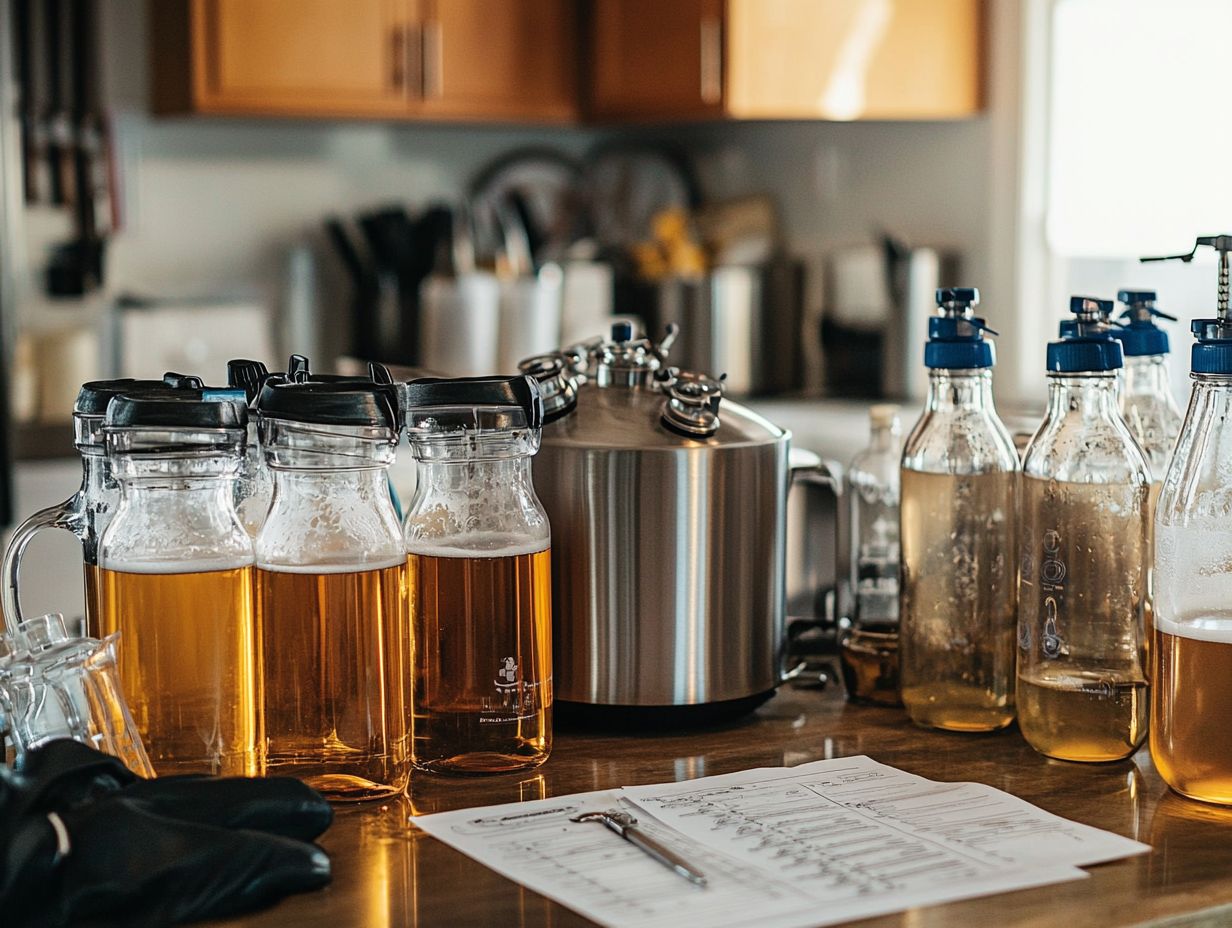
What should I do to ensure my brewing equipment is safe?
- Regularly clean and sanitize your equipment.
- Inspect for damages or wear.
- Use proper handling and storage techniques.
Utilizing effective cleaning agents and sanitizer solutions like Star San and PBW will help maintain the equipment’s condition.
How often should I clean and sanitize my brewing equipment?
You should clean and sanitize your brewing equipment after each use. Additionally, perform a deep clean at least once every three months. Regularly cleaning fermentation equipment and draft lines ensures the removal of any unwanted yeast strains or bacteria.
What are some common damages I should look for in my brewing equipment?
Some common damages to look for in brewing equipment include cracks, rust, and buildup of residue or bacteria.
Why is it important to inspect my brewing equipment for damages?
Inspecting your brewing equipment for damages is important because it can affect the quality and safety of your brew. It can also prevent any accidents or injuries. Common signs of wear can include cracks, rust, and buildup of bacteria or mold, which can lead to unintended funk in your beer.
What are some proper handling techniques for brewing equipment?
Proper handling techniques for brewing equipment include:
- Using protective gear such as gloves and goggles.
- Following manufacturer’s instructions.
- Being careful when handling hot liquids or sharp objects.
This also involves using correct cleaning practices and ensuring all gear is sanitized.
How should I store my brewing equipment when not in use?
When not in use, brewing equipment should be properly cleaned and dried. Store it in a clean and dry area away from any potential sources of contamination. Storing your equipment correctly keeps it in top shape and ensures your beer tastes fantastic!


